History of the Pro Cathedral
At last an edifice worthy of the loftiness of our creed stands in the centre of the metropolis. Our religion has at last lifted up its proud and majestic head.
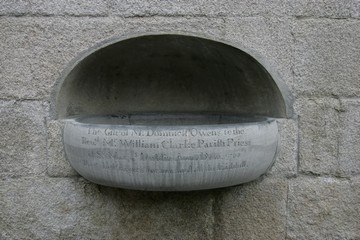 The speaker was Richard Sheil, a lawyer and a future MP, and the occasion was the reception following the dedication of the Roman Catholic Metropolitan Cha pel, as it was then called, on Monday, 14 November, 1825. It was the Feast of St. Laurence O’Toole, patron of the Archdiocese of Dublin, whose fortieth successor, Dr Daniel Murray, had just celebrated the inaugural High Mass in the new church, dedicated to the ‘Conception of the Virgin Mary’. Mr Sheil’s rather effusive remarks must be understood in the context of the times and the history of centuries.
The speaker was Richard Sheil, a lawyer and a future MP, and the occasion was the reception following the dedication of the Roman Catholic Metropolitan Cha pel, as it was then called, on Monday, 14 November, 1825. It was the Feast of St. Laurence O’Toole, patron of the Archdiocese of Dublin, whose fortieth successor, Dr Daniel Murray, had just celebrated the inaugural High Mass in the new church, dedicated to the ‘Conception of the Virgin Mary’. Mr Sheil’s rather effusive remarks must be understood in the context of the times and the history of centuries.
A much earlier St. Mary’s had been the great Benedictine, and later Cistercian Abbey of St. Mary founded in the twelfth century. The abbey lands extended eastwards along the north side of the Liffey from the present Four Courts, due north to Constitution Hill, and east to the Tolka and the sea. For four centuries the abbey flourished becoming one of the wealthiest in Ireland. The abbot was an ex-officio member of the Council of State, which met in St. Mary’s Chapter House.
However, in 1539, as at all religious houses, the monks of St. Mary’s were forced to surrender their lands and possessions, while all ‘popish trappings’ were thrown out. The abbey lands continued unoccupied except for farmers and stewards until 1676, when the opening of Essex Bridge (now Capel Street Bridge), built from the stones of the ruined abbey, pointed to the extension of the city north of the Liffey. The land was broken up, streets were laid out and named after the various landowners. Ironically, Lord Drogheda named four streets in his portion of St. Mary’s Abbey lands after himself: Henry, Moore, Earl and Drogheda (later O’Connell) Street. In 1728, Great Marlborough Street, named after the Great Duke, was the extreme eastern boundary of those abbey lands that had been broken up and built on. This was an area more than sufficient to justify the erection of a new parish. The state, by Act of Parliament, created the (Protestant) Parish of St. Mary in 1697, and ten years later Archbishop Byrne, although in hiding, made it the Catholic Parish of St. Mary.
John Linegar became the first pastor of the new St. Mary’s parish. Ten years earlier he had returned from ordination in Lisbon to a curacy in St. Michan’s. In the worst period of the penal times, his life was one of danger and narrow escapes form priest hunters anxious to enrich themselves by turning in a popish priest. Now he found himself appointed to a parish without church or chapel of any kind. But in spite of the risk he began collecting for a chapel, as well as performing his everyday priestly work saying Mass and giving instruction in rooms lent by sympathisers. It took him twenty-two years to save enough to build a modest chapel, but in 1729 St. Mary’s, Liffey Street was opened.
Though the castle authorities listed it as ‘Liffey Street mass-house’ it was considered quite a fine chapel at that time. A British Museum manuscript, written in 1749, describes the altar, the pulpit, the paintings, the confessionals and ‘two galleries, several pews for better sort, and two sprinkling pots of black marble in chapel yard.’ One of these ‘sprinkling pots’ of holy water fonts is now inserted in the wall of the Pro-Cathedral near the south-west corner.
In 1786 John Thomas Troy, a Dominican priest, who had been appointed Bishop of Ossory ten years earlier, was transferred to Dublin as Archbishop. He petitioned the Pope to allow him to take St. Mary’s as his mensal parish. The request was granted and immediately Dr. Troy began to set aside whatever funds came his way to build a ‘dignified spacious church’ in a central location. The Liffey Street St. Mary’s had served its time and purpose.
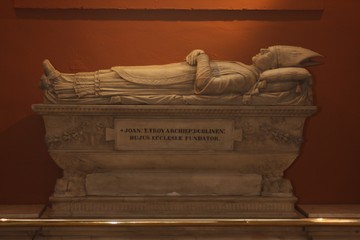 Unfortunately, further trouble lay ahead. The rebellion of 1798 and consequent reprisals postponed his plans and made his intention of building a large, central church seem an almost impossible dream. Catholic Emancipation did not, as hoped, come with the Act of Union passed in 1800. Even the siting of the new church tells its own tale. When in 1796, Drogheda Street (later O’Connell Street) was widened on its west side to align it with Sackville Street and become Dublin’s premier thoroughfare, one of the sites on offer was considered for the new St. Mary’s. However, it was feared that such a bold step might only delay or jeopardise Emancipation, so Dr. Troy’s attention was directed to a less conspicuous spot nearby, leaving the Sackville Street property to become the site of the new general post office.
Unfortunately, further trouble lay ahead. The rebellion of 1798 and consequent reprisals postponed his plans and made his intention of building a large, central church seem an almost impossible dream. Catholic Emancipation did not, as hoped, come with the Act of Union passed in 1800. Even the siting of the new church tells its own tale. When in 1796, Drogheda Street (later O’Connell Street) was widened on its west side to align it with Sackville Street and become Dublin’s premier thoroughfare, one of the sites on offer was considered for the new St. Mary’s. However, it was feared that such a bold step might only delay or jeopardise Emancipation, so Dr. Troy’s attention was directed to a less conspicuous spot nearby, leaving the Sackville Street property to become the site of the new general post office.
By 1803 a committee formed by Dr. Troy had managed to put together sufficient funds to make a deposit on Lord Annesley’s town house. This fine mansion stood on the corner of Marlborough Street and what was then known as Elephant Lane, later Tyrone Place, now Cathedral Street. It cost £5,100. However, a further twelve years were to elapse before the foundation stone of the new church was laid. During that time the collection of money continued slowly and with difficulty. In June 1814 the committee took the plunge, a demolition squad moved in, and a notice appeared in the newspapers inviting designs for the intended building. A design marked with the letter ‘P’ for a church in the form of a Grecian Doric temple was chosen as the winner. To this day the identity of ‘P’ is a matter of speculation among architectural historians. Some believe he is John Sweetman, a Dubliner exiled in Paris after the 1798 rebellion. A more likely opinion is that, although Sweetman sent the plans to Dublin, the architect was French, Louis Hippolyte leBas, whose Parisian church of Notre Dame de Lorette closely resembles St. Mary’s. Secrecy about his identity would have been essential as le Bas was Napoleon’s architect and England was then at war with France.
A model of the proposed church is still perfectly preserved and is one of the largest and finest architectural models in the world. The design combines a variety of styles. The exterior is Greek revival at its best. The front portico is a copy of the Temple of Theseus in Athens, and the fluted Doric columns rise without bases from the podium or floor of the church. The interior is more Roman in style than Grecian. A major alteration was the addition of a dome. One objector declared that ‘artistically and practically the dome was a mistake; it is no help to the preacher and constitutes a serious and unhappy departure from the graceful lines and principles of Grecian art.’ Another described it as ‘a beautiful deformity’. It is interesting to compare side by side the interiors of the original model and the newly completed church.
In August 1821 a flag was flown from the top of the dome to show that the shell of the building was completed. Yet much remained to be done. Money was scare and morale was low. A new fund-raising drive throughout the whole city began and Dr. Troy himself, at eighty-three years of age, went collecting from house to house in Westland Row parish. When the committee passed a resolution that this ‘splendid edifice be considered a National or Metropolitan rather that a Parish Chapel’ contributions come from farther afield. In March 1823 Pope Pius VII sent a beautiful gold chalice, specially commissioned ‘for the new Cathedral being built in Dublin’.
But two months later, on May 11, Dr. Troy, who had been the driving force behind the construction of the building, died. His requiem was the first Mass celebrated within the walls of the unfinished building. Although his remains now lie in the vaults underneath the church, at the time of his death they were brought as a temporary measure to the crypt of George’s Hill convent. The vaults of the new church were at that stage earning valuable income, leased to the commissioners of Inland Revenue as a storage place for spirits! This arrangement ceased in 1824 and the vaults thereafter became the burial place of over 900 benefactors of the church.
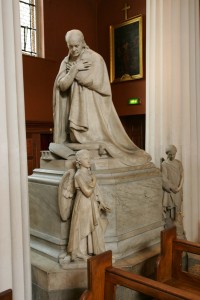 Archbishop’s Troy’s successor, Dr. Daniel Murray, gave new impetus to the completion of the building and finally the great day arrived. On November 14 1825 the church was packed for the dedication ceremony. The choir directed by Mr Haydn Corri, sang Mozart’s Grand Mass in C Minor, Ave Verum and Graun’s Te Deum. Most of the Irish hierarchy attended, a rare occurrence in those days, and the preacher was the noted J.K.L., Dr. James Doyle, Bishop of Kildare. At the reception afterwards Daniel O’Connell concluded his speech with words as apt today as they were in 1825:
Archbishop’s Troy’s successor, Dr. Daniel Murray, gave new impetus to the completion of the building and finally the great day arrived. On November 14 1825 the church was packed for the dedication ceremony. The choir directed by Mr Haydn Corri, sang Mozart’s Grand Mass in C Minor, Ave Verum and Graun’s Te Deum. Most of the Irish hierarchy attended, a rare occurrence in those days, and the preacher was the noted J.K.L., Dr. James Doyle, Bishop of Kildare. At the reception afterwards Daniel O’Connell concluded his speech with words as apt today as they were in 1825:
If all classes of Irish men were united, if the demon of discord was cast out from among them, what a happy country, how blessed beyond example Ireland should be.
Four years later, when Catholic Emancipation was granted, O’Connell was present at a special thanksgiving Mass in the Pro-Cathedral, and in 1841, as the first Catholic Lord Mayor of Dublin since the Reformation, he drove in state among cheering crowds to Mass in Marlborough Street wearing his mayoral robes and chain of office; because of laws still in force his official regalia had to be left outside the church. O’Connell died in Genoa in 1847. His remains were brought home by ship and, amid scenes of universal grief, borne from Custom House Quay to the Pro-Cathedral, where the coffin lay for four days upon a great catafalque. The church was draped in black.
After the dedication the interior embellishment of the church continued. The superb alto-relief of the Ascension is the work of John Smyth, while the High Altar was carved by Mr Turnerelli, a Belfast-born, Dublin-reared sculptor of Italian parentage. The energetic Dr Hamilton, the second Administrator, completed the church both outside and within. The entire work had cost £45,000 and every penny of the debt was cleared by 1844.
In 1852 Archbishop Murray died and was succeeded by Paul Cullen, one of the most influential figures in nineteenth century church history. Both Archbishop Murray and Dr Cullen are commemorated in the Pro-Cathedral by two monuments in marble, among the finest work of the sculptor Thomas Farrell. Murray is depicted in a kneeling pose and his image is said to bear a remarkable likeness to the man. Around the base of the standing figure of Cullen are scenes depicting his life and work as Archbishop, among them his concern for the sick poor, for the training of priests and for Catholic education in a climate of proselytism.
From the very outset of his episcopacy, Dr Cullen pursued a policy of independence from the government and steadfastly opposed state interference in church affairs. He spared no effort in rehabilitating a people emerging from centuries of oppression, intimidation and deprivation. Among the major issues he tackled was the provision of a Catholic university. He persuaded a reluctant John Henry Newman to become its first Rector, and on Pentecost Sunday 1854, Newman was solemnly installed at a ceremony in the Pro-Cathedral and made his profession of faith in the presence of Dr. Cullen.
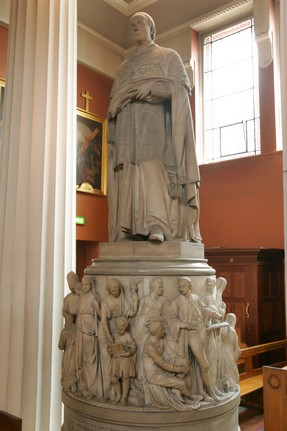 Later that same year the Immaculate Conception of Our Lady was defined as an article of faith. Special ceremonies were held in St. Mary’s, since Archbishop Byrne, back in 1707, had named the parish of Our Lady under the title of her Immaculate Conception. When in Rome for the definition of the dogma, Cullen reorganised the Cathedral Chapter first established in 1219 by Archbishop Henry Loundres in Christ Church Cathedral. By decree of Pius IX the reorganised Dublin Metropolitan Chapter was to meet in the Pro-Cathedral, at first monthly, later six times annually, to chant some portion of the Divine Office and celebrate a Solemn Mass. Their first meeting was in October 1855. Cullen was back again in Rome in 1866 to receive the red hat as Ireland’s first resident cardinal.
Later that same year the Immaculate Conception of Our Lady was defined as an article of faith. Special ceremonies were held in St. Mary’s, since Archbishop Byrne, back in 1707, had named the parish of Our Lady under the title of her Immaculate Conception. When in Rome for the definition of the dogma, Cullen reorganised the Cathedral Chapter first established in 1219 by Archbishop Henry Loundres in Christ Church Cathedral. By decree of Pius IX the reorganised Dublin Metropolitan Chapter was to meet in the Pro-Cathedral, at first monthly, later six times annually, to chant some portion of the Divine Office and celebrate a Solemn Mass. Their first meeting was in October 1855. Cullen was back again in Rome in 1866 to receive the red hat as Ireland’s first resident cardinal.
Fr. Edward McCabe, later to succeed Cardinal Cullen as Archbishop, was curate of Marlborough Street for three years, and Administrator for three months in 1856. During his time there he was Spiritual Director to the recently formed Association of Ladies of Charity of St. Vincent de Paul, who were especially concerned with the welfare of children of the poor. Their president was Miss Margaret Aylward, and with his help and advice she later founded St. Brigid’s Orphanage and the Holy Faith Sisters.
St. Mary’s had by now established itself as the centre of life in Catholic Dublin. John Hogan and other leading sculptors of the day carved beautiful and elaborate memorials to benefactors of the diocese to be erected within its walls, and valuable gifts of altar plate were presented to the church. One of these is the fine silver-gilt chalice, paten and cruet set presented in 1856 in honour of St. Laurence O’Toole by Mary Teresa Talbot, the Countess of Shrewsbury, who was a descendant of the O’Toole family.
The church was also the venue for various public meetings convened to address major issues of the day. There were 23,753 signatures on a requisition to the archbishop to call a general meeting in January 1860 to protest at the invasion of the Papal States. The collection on that occasion began the annual tribute known as Peter’s Pence. A few months later on the day of the Feast of the Holy Cross, 3 May, after Solemn Mass in the Pro-Cathedral, bishops and clergy proceeded to Clonliffe and laid the foundation stone for Dublin’s seminary, Holy Cross College.
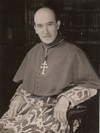 Edward McCabe became Cardinal Cullen’s successor in 1879, and three years later, like his predecessor Cullen, received a cardinal’s hat from Pope Leo XIII. He returned from Rome to find Ireland in turmoil after the Phoenix Park murders. It gave him a shock from which he never fully recovered, and shortly afterwards he died. His successor, Archbishop William Walsh, who was to serve for the next thirty-five years, was installed in the Pro-Cathedral in September 1885.
Edward McCabe became Cardinal Cullen’s successor in 1879, and three years later, like his predecessor Cullen, received a cardinal’s hat from Pope Leo XIII. He returned from Rome to find Ireland in turmoil after the Phoenix Park murders. It gave him a shock from which he never fully recovered, and shortly afterwards he died. His successor, Archbishop William Walsh, who was to serve for the next thirty-five years, was installed in the Pro-Cathedral in September 1885.
One of Dr. Walsh’s first moves was to inaugurate a fund for the redecoration of the Pro-Cathedral. At a public meeting in the church in May 1886, £800 was raised, to which a Mr Ryder added a magnificent gift of £1,000 the following October, and the work was begun. In keeping with the style of the Victorian age, the decoration was highly ornate. Biblical scenes traversed the ceiling bands, every panel of the entablature bore a different saint’s head, intricate traceries surrounded religious symbols, and Latin inscriptions in gilt lettering ran round the interior of the dome and the pediment atop the Doric columns. To this period also we can attribute the fine stained-glass window behind the sanctuary, depicting Our Lady of the Immaculate Conception flanked in two side panels by the diocesan patrons St. Laurence O’Toole and St. Kevin. In 1908 two beautiful altars to Our Lady and the Sacred Heart were added. They are fine examples of the combination of marble and mosaic in late-Victorian religious art. At the same time the large semi-circular windows on each side of the dome were provided; this vastly improved the light and ventilation of the building.
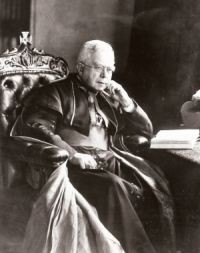 The 1886 embellishments were painted over in a later refurbishment of the building, but we can be thankful to William Lawrence for including the Pro-Cathedral in his priceless collection of photographs from the early years of the century. In his exterior shot of the church it is interesting to note the functional gaslights on the railings and the then recently-planted young saplings in the grounds of the Department of Education building across the street.
The 1886 embellishments were painted over in a later refurbishment of the building, but we can be thankful to William Lawrence for including the Pro-Cathedral in his priceless collection of photographs from the early years of the century. In his exterior shot of the church it is interesting to note the functional gaslights on the railings and the then recently-planted young saplings in the grounds of the Department of Education building across the street.
One occasion followed another in the Pro-Cathedral. Ireland achieved independence in 1921, the year that Archbishop Walsh died. His successor, Dr. Edward Byrne, tried his best to avert a civil war, but without success. Soon afterwards, in August 1922, it was his sad duty to preside at the funeral of one of the leading Republican figures, Michael Collins. A sombre and poignant painting by Sir John Lavery, which hangs in Áras an Uachtaráin, depicts the moment of the elevation of the Host during the Funeral Mass in the Pro-Cathedral. Tradition claims this as the first time that the new national flag, the Tricolour, draped the coffin of a slain Irish soldier during a religious service.
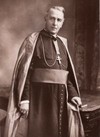 The remains of the other main protagonist in the same civil war, Eamon De Valera, were laid on the same spot fifty three years later, in September 1975. During his long life he had been a frequent visitor to Marlborough Street, as Taoiseach and President.
The remains of the other main protagonist in the same civil war, Eamon De Valera, were laid on the same spot fifty three years later, in September 1975. During his long life he had been a frequent visitor to Marlborough Street, as Taoiseach and President.
In 1928, in preparation for both the Centenary of Emancipation celebrations and the forthcoming Eucharistic Congress, the floor space within the church was extended on both sides – another unhappy alteration of John Sweetman’s original design. The elegant portico on the Cathedral Street side was walled up between the Doric columns, and what had been up to then St. Kevin’s chapel in the northern flank became simply open space within the church. The fact that sightlines from that area to the sanctuary are very poor seems to have been overridden by the need to squeeze as many as possible into the church for the coming big occasions. By June 1932, garlands and great baskets of hanging flowers decorated the portico and the interior of the church for the Solemn Opening of the Congress. The whole world flocked to Dublin, and the register of visiting bishops and priests at the Pro-Cathedral gives some idea of the international dimension of the event. Among the vestments still used at St. Mary’s is the cope worn by the Cardinal Legate at Benediction on O’Connell Bridge. The official symbol of the Congress, a raised chalice and host superimposed on the Cross of Cong, still adorns the balcony over the main entrance of the Pro-Cathedral.
In 1902 a radical change took place in the organisation of the Cathedral choir. A wealthy Galway landowner, Edward Martyn, offered to endow a choir of boys and men at the Pro-Cathedral which would specialise in singing music by the great classical composers of polyphony. The most notable of these was Palestrina, and the choir would be named the Palestrina Choir. Archbishop Walsh, a keen musician himself, gladly accepted the offer and Dr. Vincent O’Brien was appointed the first director. In the same year Martyn received a letter from a young Athlone man asking if he might join the new choir. Martyn wrote afterwards:
I replied stating that Mr. McCormack should come up to Dublin and let us hear him. He came early in 1903 and when we heard his astonishing voice I immediately secured him for the choir. It is not a big voice although the quality and tone is refreshing.
Under Dr. O’Brien’s tuition John McCormack sang with the choir for some years and then won the Feis Ceoil his first step to world fame. In recent years the choir members have followed his lead and won major awards in the Dublin Feis Ceoil. The choir sings the 11.00a.m. Mass each Sunday in the Pro-Cathedral and at major ceremonies throughout the year. They have also travelled widely abroad and sung in the cathedrals of Westminster and Liverpool, Notre Dame in Paris and in St. Peter’s, Rome.
The present organ, standing impressively in William Hill’s imposing case of 1908, was rebuilt in 1971 by J.W. Walker and Sons, as a three manual organ of thirty two speaking stops. One of the few organs in Ireland with a 32ft pedal stop, it is much admired for its warmth of tone and versatility of character. Although primarily used to enhance the daily liturgies of the cathedral, this organ is one of Dublin’s main recital instruments on which many internationally eminent players have performed.
When the original St. Kevin’s chapel was incorporated into the main church in the late twenties, another building was erected as a chapel to the north of the Pro-Cathedral, at the rear of the parochial houses but fronting onto Thomas’s Lane. This narrow street was originally a service lane to the great houses which stood on Marlborough and present day O’Connell Street. It still serves that function but the carriages of the nobility have been replaced by Bord Telecom vans and supply trucks to the Gresham Hotel. Baptisms and marriages take place nowadays in this later St. Kevin’s. Numbers have dropped considerably since Dublin Corporation levelled city centre flat complexes in the the 1970’s and decimated the population of St. Mary’s parish. But the records are still preserved, even of baptisms which took place in the Liffey Street chapel, and prove a valuable hunting ground for genealogists and historians from all over the English speaking world. Among the hundreds of thousands of entries is one for Matthew, son of Charles and Elizabeth Talbot, baptised in the Pro-Cathedral on 5 May, 1856. This child was destined to become a servant of God, the first step to sainthood.
St. Kevin’s is a rectangular shaped chapel lit by seven semi-circular windows at an upper level. Over the marble altar and framed by two Corinthian columns is a painting of St. Kevin of Glendalough. A famous Dublin Capuchin Friar, Fr. Angelus, was the model for St. Kevin. The recently restored Stations of the Cross are a fine example of the mid-nineteenth century Flemish school of painting.
One of the most valuable items in the Pro-Cathedral treasury is the great monstrance. This beautifully wrought silver-gilt article is used to hold the Sacred Host during Exposition of the Blessed Sacrament. The stem connecting the base to the upper display section takes the form of an angel announcing the presence of Christ to the world. In this connection we should note that it was here in the Pro-Cathedral that the Forty Hours Adoration of the Blessed Sacrament devotion began. At the very start of Cardinal Cullen’s administration in Dublin, on 18 September 1850, he issued a pastoral letter announcing that the general jubilee proclaimed that year by Pope Pius IX would commence in Marlborough Street on Friday, 1 October with Pontifical Mass, followed by Forty Hours of Adoration until the following Sunday. He gave an instruction that the devotion inaugurated in the Pro-Cathedral should be carried out in every church and chapel in the city. Country parishes soon followed suit. The devotion was welcomed with great enthusiasm by the populace and has become a regular annual event in every parish ever since.
 To Archbishop John Charles McQuaid, who succeeded Dr. Byrne in 1940 we owe the Pro-Cathedral’s newest altar dedicated to St. Laurence O’Toole. He had it erected as a memorial to his predecessor. In a precious reliquary it contains a major relic of the twelfth century Saint.
To Archbishop John Charles McQuaid, who succeeded Dr. Byrne in 1940 we owe the Pro-Cathedral’s newest altar dedicated to St. Laurence O’Toole. He had it erected as a memorial to his predecessor. In a precious reliquary it contains a major relic of the twelfth century Saint.
We may also thank Dr. McQuaid that the sound of the Pro-Cathedral bell is familiar to many throughout Ireland. He agreed with Radio Eireann that it be used for the daily Angelus on radio. (Sadly, that record has recently worn out and it would be impossible to record the bell nowadays without the constant interupption of city centre traffic.) Originally cast in 1844, the bell bears the inscription (tranlated from Latin):
O Mary preserved from original sin, hail to thee to whom I was dedicated by Archbishop Daniel (Murray) in the year 1844. Worn thin by the passage of time, I was completely recast and restored to my original form and once again dedicated to thee O Immaculate Virgin on 2nd July 1907 by William (Walsh) Archbishop of Dublin.
Whether it had an extra silver tint after 1907 we will never know, but Fr. Myles Ronan P.P., a member of the Royal Irish Acadamy, wrote in the Dublin Historical Record: “a good deal of silver was used in the recast. We, the curates at the time threw a large number of half-crowns into the melting pot!”
Towards the end of the 1970s major repairs became necessary to the roof of the Pro-Cathedral. Pollution had caused the nails used to secure the slates to erode. The loose slates would slide down the roof to the valleys, puncture the lead flashings and so allow rain water through. The old lead had to be replacec by copper and the heavy slates cleaned, examined and replaced where necessary. It was a slow, painstaking job and took a year to complete.
At the same time it became necessary to adapt the sanctuary of the churc to post-Vatican II liturgical requirements. Archbishop Dermot Ryan and Administrator Fr. Paddy Dowling decided to remove the Turnerelli altar and redesign the sanctuary area. The architect was Cathal O’Neill, Professor of Architecture in University College, Dublin. The sanctuary area was raised and enlagged, and paved with Portland stone. The original Portland flags were taken to Ballycrew quarry and dressed anew. They were then re-laid together with some new flags. The new altar, incorporating the front panel of the old, with Turnerelli’s adoring angels was dedicated by Archbishop Dermot Ryan on Sunday 31 January 1982.
During Dr. Ryan’s episcopate the Dublin Diocesan Social Service Centre was set up at the Pro-Cathedral. Known initially as ‘The Open Door’ but now as Centrecare, the agency provides a professional counselling and advice service to people who come with a variety of social problems and cares. At first the small but energetic team of social workers were accommodated in rooms over the south-west entrance to the building, but as demand increased other premises had to be acquired and more extensive space was leased in Cathedral Street, opposite the south flank of the church. Another Pro-Cathedral agency, the counselling and adoption service for single mothers operated from 82 Marlborough Street.
New developments in the liturgical life of the Pro-Cathedral have centred on young adults in particular and under twenty fives who number fifty per cent of the Irish population. Pope John Paul II, during his Irish visit in 1979, said:
Every generation is like a new continent to be won for Christ. The Church must constantly look for new ways that will enable her to understand more profoundly and to carry out with renewed vigour the mission received from her founder.
The Pro-Cathedral Folk Choir a talented and enthusiastic group of young adult singers and musicians, now plays its part with the Palestrina Choir in providing for sacred ceremonies in St. Mary’s. A Liturgical Movement Group adds its own creative and prayerful dimension to special occasions. But the most important development in recent years has been a Saturday evening Mass for young adults begun in St. Kevin’s Oratory in November 1984. Seats are removed and votive lights are placed around the chapel and the whole atmosphere is one of quiet contemplation, much in the style of the monastery of Taize, in France. This world famous centre of prayer has been an inspiration for yourng people all over the globe, and its founder, Brother Roger Schutz, was welcomed to Ireland and Dublin by Archbishop Kevin McNamara in a moving ceremony in the Pro-Cathedral in May 1985. The Saturday evening Young Adult Mass in St. Kevin’s is crowded every week and numbers continue to grow. At the time of writing, this special celebration has begun in ten other centres throughout the Dublin diocese and beyond. Until his untimely death in 1987, after only two years in office, Dr. McNamra took a keen interest in, and personally supported, the apostolate to young adults at the Pro-Cathedral.
In March 1986, a spectacular Passion Play, Those Three Days, which was performed in the Pro-Cathedral for the week preceding Holy Week, combined the talents of the Abbey and Gate Theatres, both in the parish, with a large host of professional and amateur actors, local parishioners and choirs-over 300 participants in all. Appreciative Dubliners packed the church every night.
Presidents, governments and foreign ambassadors come to the Pro-Cathedral on great national occasions. The Lord Mayor and the County Council come to extend Christmas greetings to the Archbishop on behalf of the citizens of Dublin. Tourists include St. Mary’s on sightseeing trips around the city, and during the summer there are nearly as many foreign visitors as native Irish at the Sunday Masses. But above all, this great church belongs to the people of Dublin, who know it affectionately as the ‘Pro’. In an echo of earlier days, there are still residents in the neighbourhood who still refer to it as ‘the Chapel in Marlborough Street’. Every day there is a constant stream of people dropping in to light a candle and say a quiet prayer.
Few buildings have such a close association with significant moments in the political and religious history of Ireland as the Pro-Cathedral has had for nearly two centuries. Compared with cathedral in other European capitals, St. Mary’s is neither ancient nor awesome. Its site was a compromise, and it does not have an impressive facade of statuary, an exquisite rose window or a magnificent spire to be seen from afar. However, neither is it a museum; it is a living church, and it continues to be, as Archbishop Troy wanted it to be, a heart for the city and an active house of God.
(from Saint Mary’s Pro-Cathedral Dublin by Dermod McCarthy, The Irish Heritage Series, Eason and Sons Ltd. Dublin 1988)
